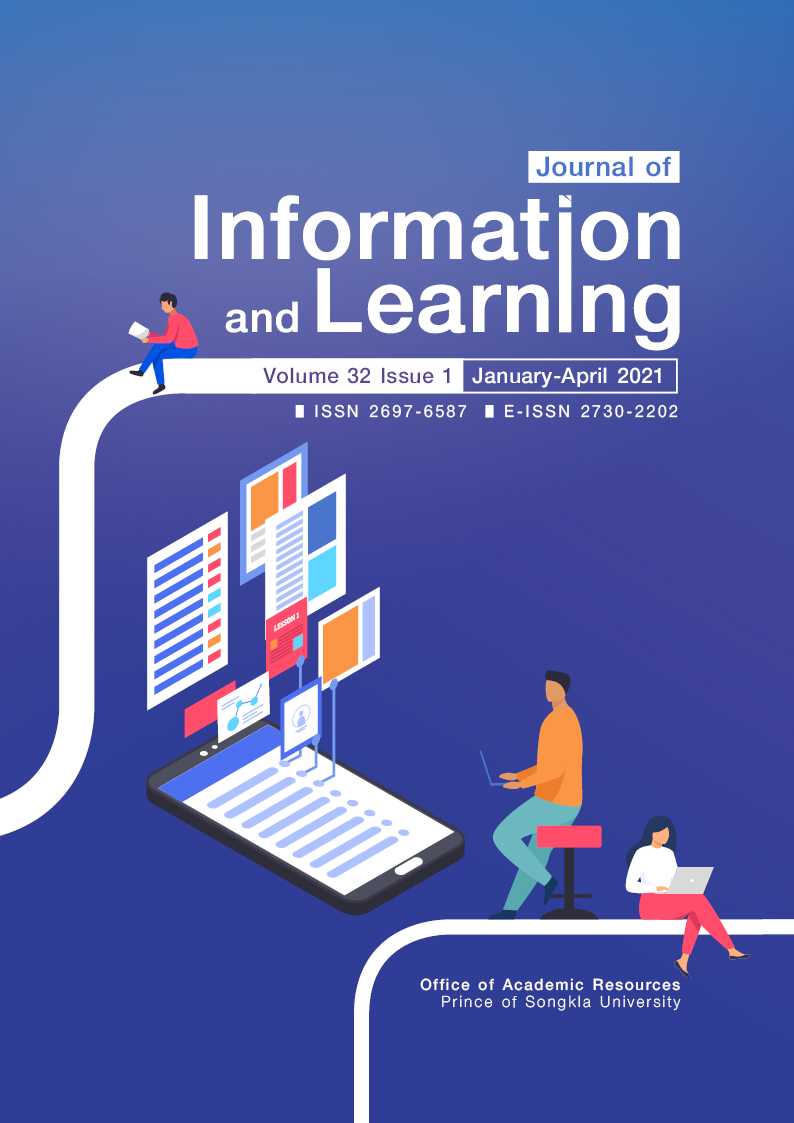Guidelines for the Application of Design Thinking Approach to the Change of Educational Institutions
Main Article Content
Abstract
Educational institutions should be transformed into innovative organizations. Design thinking is anothers concept which develops innovation in education and learning management. In order for educational institutions to be able to use innovative design thinking in a sufficient way, it is necessary to adjust the context to be consistent with innovations. Design thinking is a creative and meaningful process that is consistent with the current situation and problem. An educational institution should bring out differences into a combination, promote attention to the context of problems, and create insights through cooperative working. There are five key components: 1) empathy 2) integrative thinking 3) positive thinking or creativity 4) experiment or prototype development and 5) collaboration or testing. Educational institutions can implement the following idea: 1) setting up the policy to be innovative organizations, 2) training teachers to become innovators, 3) offering an opportunity to develop innovation, and 4) sharing knowledge and publicizing the innovation.
Article Details

This work is licensed under a Creative Commons Attribution-NonCommercial-NoDerivatives 4.0 International License.
The Journal of Information and Learning is operated by the Office of Academic Resources, Prince of Songkla University. All articles published in the journal are protected by Thailand copyright law. This copyright covers the exclusive rights to share, reproduce and distribute the article, including in electronic forms, reprints, translations, photographic reproductions, or similar. Authors own copyrights in the works they have created as well as the Office of Academic Resources. The Journal reserves the right to edit the language of papers accepted for publication for clarity and correctness, as well as to make formal changes to ensure compliance with the journal's guidelines. All authors must take public responsibility for the content of their paper.
References
Aoujirapongpan, S., Wattanasin, P., Chanchay, A., & Kuprat, P. (2011). Innovation: meaning type and important of entrepreneur. Journal of Business Administration, 33(128), 49-65.
Berengueres, J. (2013). The brown book of design thinking (6th ed.). Abu Dhabi, Al Ain: University College.
Brown, T. (2008). Design thinking. Harvard Business Review, June, 84-92.
Brown, T., & Wyatt, J. (2010). Design thinking for social innovation. Stanford, CA: Stanford Graduate School of Business.
Carlgren, L., Rauth, I., & Elmquist, E. (2016). Framing design thinking: The concept in idea and enactment. Creativity and Innovation Management, 25(1), 38-57.
Cheangkul, W. (2016). Sp̣hawa kar suksa thịy pi 2557/2558 ca pt̩irup kar suksa thịy hi thạn lok nı stawat thi 21 diy yangrị [State of Thai Education 2014/2015 “How to transform Thai education to catch up with the world in the 21st century?”]. Bangkok: Deekarnpim.
Crespell, P., & Hanson, E. (2008). Managing for innovation: insights into a successful company. Forest Products Journal, 58(9), 6-17.
Dearing, J. W., & Cox, J. G. (2018). Diffusion of innovations theory, Principles, and Practice. Health Affairs, 37(2), 183-190.
Lam, A. (2011). Innovative organizations: structure, learning and adaptation. In Innovation perspectives for the 21st Century (pp. 163-175). Madrid, Span: BBVE.
Leekpai, P. (2013). Antecedents to innovativeness and impact on firm performance. Executive Journal, 33(4), 55-63.
Matthews, J., & Wrigley, C. (2017). Design and design thinking in business and management higher education. Journal of Learning Design, 10(1), 41- 54.
Mihic, A. O., Umihanic, B., & Fazlovic, S. (2015). The role of organizational innovation in achieving and maintaining company’s business excellence. Journal of Contemporary Management Issues, 20(1), 79-100.
Nigten, A., & Kotey, H. (2017). Whitepaper: Hybrid Learning environments, Designing innovative, participatory and sustainable solutions for complex issues. doi: 10.13140/RG.2.2.28553.75362.
Office of the Education Council. (2018). Education in Thailand 2018. Bangkok: Prigwangraphics.
Pangthai, S. (2017). Roles of administrators implementing educational innovation to practice: Kukampitayasan school case. Research and Development Journal Suan Sunandha Rajabhat University, 9(1), 124-134.
Plattner, H. (n.d.). An introduction to design thinking: Process guide. Stanford, CA: institute of Design at Stanford. Retrieved from https://dschool-old.stanford.edu/sandbox/groups/designresources/wiki/36873/attachments/74b3d/ModeGuideBOOTCAMP2010L.pdf
Prajankett, O. (2014). An educational innovative organization: A new choice of educational administration. Journal of the Royal Thai Army Nurses, 15(1), 45-51.
Razavi, S. H., & Attarnezhad, O. (2013). Management of organizational innovation. International Journal of Business and Social Science, 4(1), 226-232.
Sirin, W., Kunnurat, P., & Chaiphar, W. (2015). Administrative factors affecting the achievement of becoming and innovative organization Khon Kaen University. KKU Research Journal of Humanities and Social Sciences (Graduate Studies), 3(3), 54-64.
Songmuang, J. (2015). Islamic studies instruction of 21st century. The 2nd National Conference 2015 on “Knowledge integration for Peaceful Society and The ASEAN Community Development” (pp. 183-190). Pattani, Thailand: Fatoni University.
Sousa, F. C., Pellissier, R., & Monteiro, I. P. (2012). Creativity, innovation and collaborative organizations. The International Journal of Organizational Innovation, 5(1), 1-39.
Thongsai, S. (2015). Nurse and the development of creative thinking. Journal of Phrapokklao Nursing College, 27(1), 112-119.
Thongsomjit, P., Na-songkhla, J., & Silapacharanan, S. (2013). A Community of Innovation: Technological driven system based on participatory rural appraisal and design thinking approach. Slipakorn University Journal of Sciences, Humanities and Arts, 13(2), 295-312.
Tschimmel, K. (2012). Design thinking as an effective toolkit for innovation. In Proceedings of the XXIII ISPIM Conference: Action for Innovation: Innovating from Experience (pp. 1-20). Barcelona. Retrieved from https://www.researchgate.net/publication/236135862_Design_Thinking_as_an_effective_Toolkit_for_Innovation
Zubizarreta, M., Ganzarain, J., Cuadrado, J., & Lizarralde, R. (2021). Evaluating Disruptive Innovation Project Management Capabilities. Sustainability, 13(1), 1-22.


